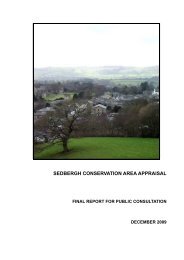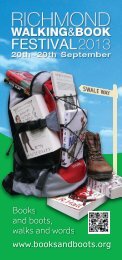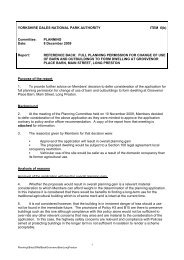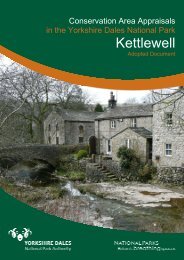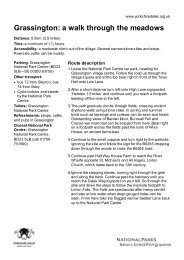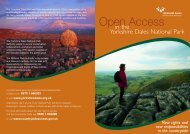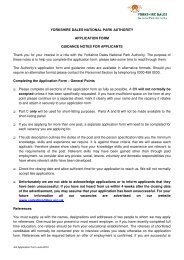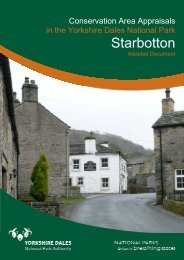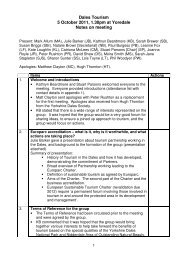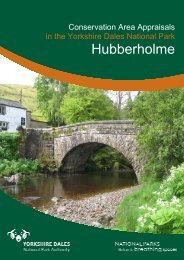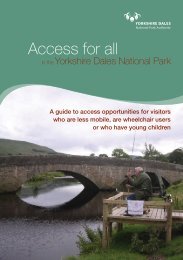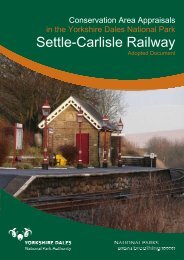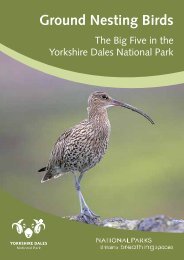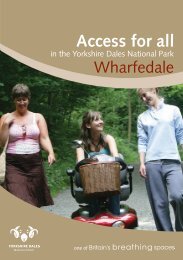Langcliffe - Yorkshire Dales National Park
Langcliffe - Yorkshire Dales National Park
Langcliffe - Yorkshire Dales National Park
- No tags were found...
Create successful ePaper yourself
Turn your PDF publications into a flip-book with our unique Google optimized e-Paper software.
1718Allinson, Judith (2000?) ‘TheFlora of <strong>Langcliffe</strong> Parish’,http://www.langcliffe.net/Flora.html.Light, Gerald (date?) ‘Birdsof <strong>Langcliffe</strong>’,http://www.langcliffe.net/Birds.html.status, but if the boundary recommendations are carried out they shouldbe considered for protection by Tree Preservation Order.Biodiversity. The flora of <strong>Langcliffe</strong> parish is special because of theuncommon plants that grow in a variety of different habitats, includingseven nationally scarce plants and one very rare plant – a special type ofLady’s Mantle – which all grow on limestone grassland, screes or cliffs.The railway and riverside verges, quarries and cliffs are also importanthabitats in an area of extensive sheep farming. Only two percent of theparish is wooded, comprising conifers, sycamores, larch, beech and ash.There is no record of bracken, which poses a great problem in other partsof the <strong>Yorkshire</strong> <strong>Dales</strong> <strong>National</strong> <strong>Park</strong> 17 .<strong>Langcliffe</strong> boasts a variety of habitats for birds, such as the river, villageand valley slopes, attracting a good range of birds throughout the year.Over the last century, the numbers of some birds have changedconsiderably. Tree planting of indigenous deciduous species would be apositive step for breeding birds and other forms of wildlife in general 18 .h) Extent of Intrusion or Damage (Negative Factors)Features that harm the character or appearance of the area should eithermake way for positive change or, if that is not possible, be excluded fromthe boundary. The elements which detract from the special interest of the<strong>Langcliffe</strong> Conservation Area are as follows:In the public realm: Car parking dominating the street scene Inappropriate modern street lighting style Overhead telephone lines and timber poles Over-ridden grass verges Some inappropriate signage Unattractive patched-up tarmac road surfaces Weeds growing in public areasOn private property: Intrusive aerials Unsympathetic building conversions to residential use,destroying the original architectural language and itssetting Unsympathetic modern construction types that do notrespect the proportion, form and scale of the existing builtenvironmentPublic realm. While the car parking issue is difficult to solve (see 4.4.k),good-quality repairs to road surfaces and verges should an achievablestandard for the highways authority. Likewise, some of the signage couldbe de-cluttered while the street lighting needs to blend in more with theappearance of the conservation area. Removing weeds from publicplaces, especially around the memorial fountain (figure 20), could beundertaken communally.Private property. Unsympathetic building conversions or modernconstruction types can have a destructive effect on any conservationarea. Damage of the former kind is easily brought upon by seeminglysmall interventions like adding, changing or removing openings, fixturesand fittings. Using a local barn conversion as a typical example (figure37), it becomes obvious that the original character of this particularagricultural building has now been lost forever. Here, the conversion wasfirst approved in 1975 and then, in modified form, in 1987, with furtheralterations to the property and its curtilage granted up until 2008.36



